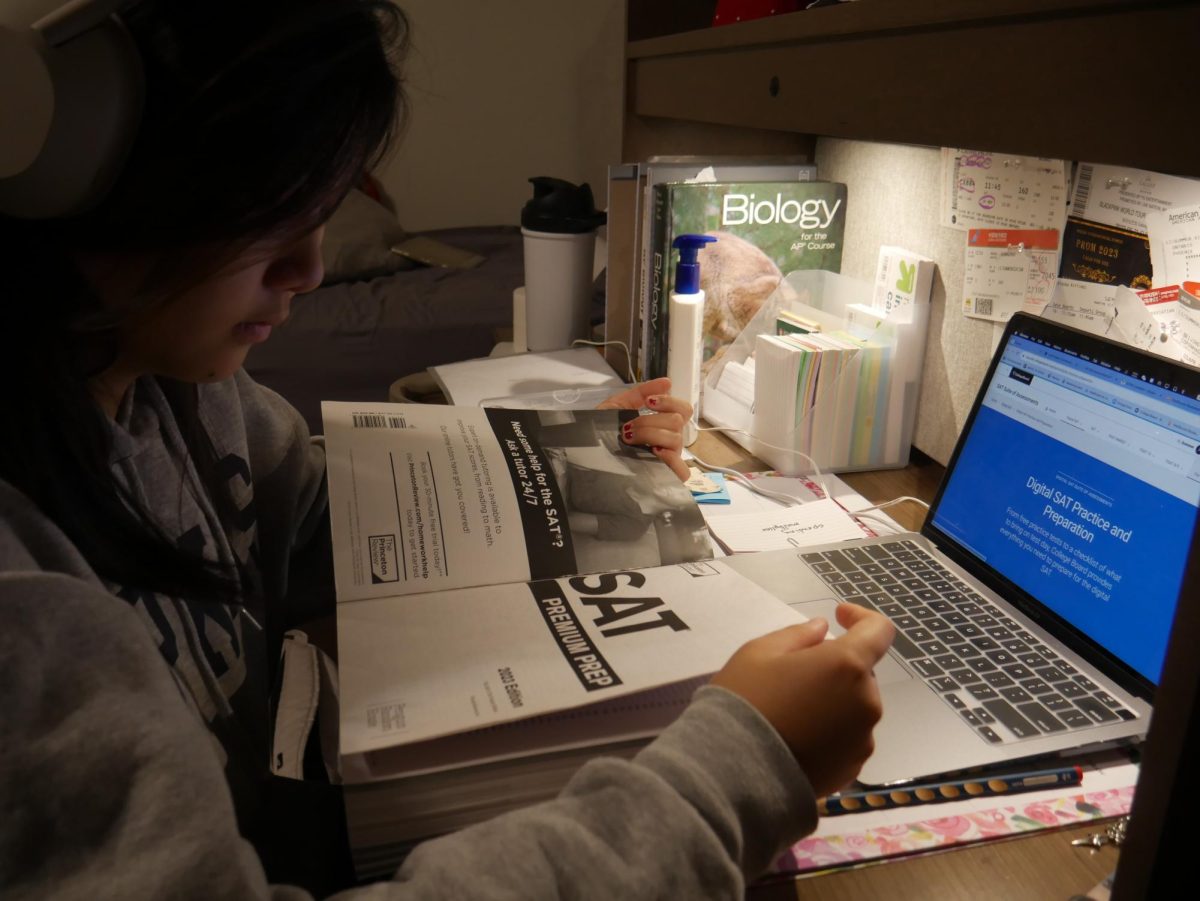Since its inception in 1926, the SAT has been a paper-based test. Now, starting in March 2024, U.S. students will take the digital, adaptive SAT. The updated SAT is shorter, lasting two hours and 14 minutes instead of the previous three hours and 15 minutes, and is designed to better accommodate students’ concentration levels.
“I can’t pay attention for such a long period. The SAT used to take about three hours, but now it’s only two, which is much better for me,” Jocelyn Reyes ‘25 said.
In preparation for the digital SAT, junior students were the first class at Flintridge Sacred Heart Academy to ever undergo the digital PSAT this fall.
“We decided to go digital only for juniors this year. Ninth and tenth [grade] were given the paper PSAT because I was worried about connection issues,” Mrs. Kathy Desmond, Academic Dean, said.
CollegeBoard designed the exam to withstand internet outages, which ensures that students won’t face any disruptions and can proceed smoothly, with all their work saved, preventing any loss of testing time.
Another innovation of the digital SAT is something new called the Bluebook App. Upon installation, the app directly downloads exam questions to the student’s device. Additionally, the app activates a “lockdown” feature, preventing access to any other applications on the device throughout its operation.
The SAT will continue to be proctored at schools or testing sites. Mrs. Desmond notes that the app has streamlined test monitoring for proctors, and with students receiving different test versions, concerns about cheating are essentially alleviated.
“What you do have to watch as a proctor is watching the app and making sure that students aren’t going from section to section,” Mrs. Desmond said.
Similar to the paper format, the digital version of the SAT also maintains the rule that prohibits moving from one section to another. For instance, a student can’t return to the reading section if they are designated to work exclusively on the math section during a specific time.
In addition to more rigorous proctoring, the digital SAT offers the benefit of faster score returns, delivering results within days rather than weeks.
“I’m excited to get my scores back faster because usually when it takes a long time for me to get back my tests, I forget that I took them in the first place and they’re not really on my mind anymore,” Summer Li ‘25 said.
The digital SAT eliminates the need for physical test papers to be collected, transported and manually scored, as was the case with the traditional paper-and-pencil SAT.
“Normally, I would have to count all the books, all the answer sheets and then fill out this form. I’d have to then send the answer sheets back and wait for them to be processed,” Mrs. Desmond said. “But for the digital PSAT, I didn’t have to send back any test booklets. Students submitted their responses online and then I just made sure everything was submitted.”
Apart from receiving scores quicker, another advantage of the digital SAT is a reduced likelihood of bubbling errors.
“The scantrons are really overwhelming to look at and it can be even more difficult if you accidentally skip one of the bubbles. I’ve had that happen to me multiple times,” Abigail Sun ‘25 said.
According to online education company PrepScholar, the digital SAT format will include a countdown timer at the top of the testing screen, allowing students to monitor the remaining time in each stage of the exam. Additionally, the exam provides an option to hide the clock and issues an alert when there are five minutes left in the module.
“It’s nice that you can see all the questions [on the digital version], but also, seeing the time stresses me out and makes me less focused on the actual question and more focused on rushing through the problems. Staring at my computer screen while taking digital tests also just makes me feel fatigued,” Li said.
Other Tologs believe that the customization features on the digital SAT, such as enlarging the font size and adjusting the background color to light or dark, can help students perform better by catering to their preferences.
“My eyesight isn’t bad, but I tend to stare closely at the paper during paper tests because I feel like it helps me better understand the content when I’m closer to the material. Making it [the font size] bigger makes that a little easier without having to physically lean into it,” Sun said.
Sun also finds the display of time beneficial as it helps her keep track of remaining questions.
“I took the digital PSAT which helped me more with the timing [of the test]. It had a clock with seconds, so that helped me plan out how long I needed to take on each question instead of having to go off just the minutes and having to stress about exactly how much time I had left,” Sun said.
In contrast to the paper SAT, which included one math section with a calculator and one without, the digital SAT provides a Desmos graphing calculator feature in both versions of the math section. While this tool can be beneficial for students, some perceive it as a drawback since they cannot directly download programs with formulas into their calculators which they were allowed to do with the paper SAT.
“There are some things that the calculator can do that Desmos can’t, so I think that being able to use a physical calculator is an advantage because you can download a lot of different programs,” Reyes said.
PrepScholar furthermore acknowledges that reading passages are now shorter compared to the paper exam, and instead of responding to multiple questions for a single passage, students now answer only one.
“The reading passages used to be super long, which would make me lose my attention and lose the purpose of the text. Since they’re now so much shorter, I’m able to focus more on what the question is asking regarding the passage. I felt that with the longer passages, I couldn’t obtain what it was trying to prove, and it felt more difficult having to look back and having such a long passage to try and find the answer,” Reyes said.
Adapting to this new era of online standardized testing may require some adjustment.
“I need to annotate questions and the tools on the digital SAT or at least the PSAT were like reading an E-book. You have to use a highlight tool and I can’t really write out a description of what my thoughts are,” Zara Savadian ‘25 said.
There are numerous online resources available for students to prepare for the exam and for the new digital format, through online practice tests.
“I did a lot of online practicing. I’d recommend doing practice problems and official practice tests as those were really helpful when I was preparing for mine [standardized test],” Sun said.


